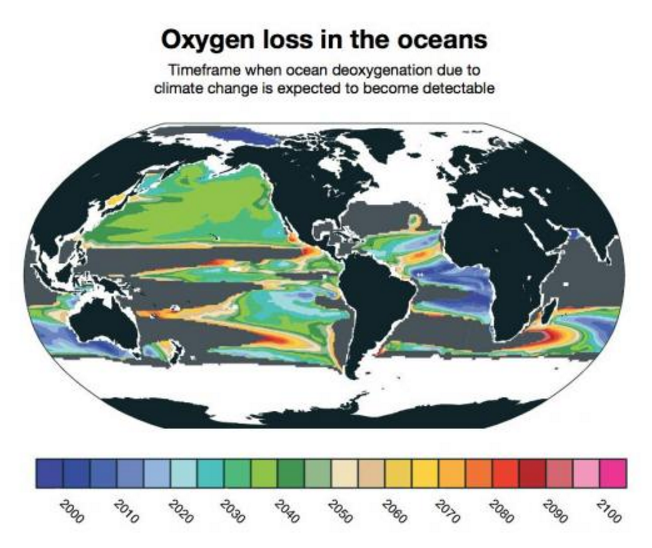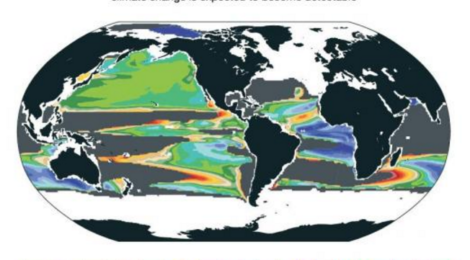
Ocean Oxygen Producing Phyto-Plankton Must Be Restored To Save Sea Life
Ocean oxygen forecast to be disastrously low by 2030 to 2040 says new scientific report.
This oxygen decline follows in lock step with the collapse of ocean pasture photosynthesis.
This is only a doomsday story if we do nothing to restore ocean primary pasture productivity and replenish oxygen to sustain ocean life and more. It is vital we do this it’s a matter of life and breath, two out of every three breaths of oxygen you take in contains oxygen made by ocean plant-life!
A dire reduction in the amount of ocean oxygen due to high and rising CO2 is already discernible in some parts of the world and will be very evident and much worse across large regions of the world’s seven seas between 2030 and 2040, according to a new study led by the National Center for Atmospheric Research (NCAR). Researchers published their findings in the journal Global Biogeochemical Cycles.
Scientists have known and widely reported that the impacts of CO2 globally have an especially dire effect in the 72% of this Blue Planet that is ocean. Already during the a hundred years of yesterdays in our fossil fuel age we have emitted about a trillion tonnes of CO2 into the world’s air, yesterday’s CO2.
The vast majority of that CO2 is headed into the oceans but some is working miracles on land. Our high and rising CO2 has been nourishing green plants on land a global greening has been taking place. That may sound like good news to many, after all we humans live on land and love our greenery.
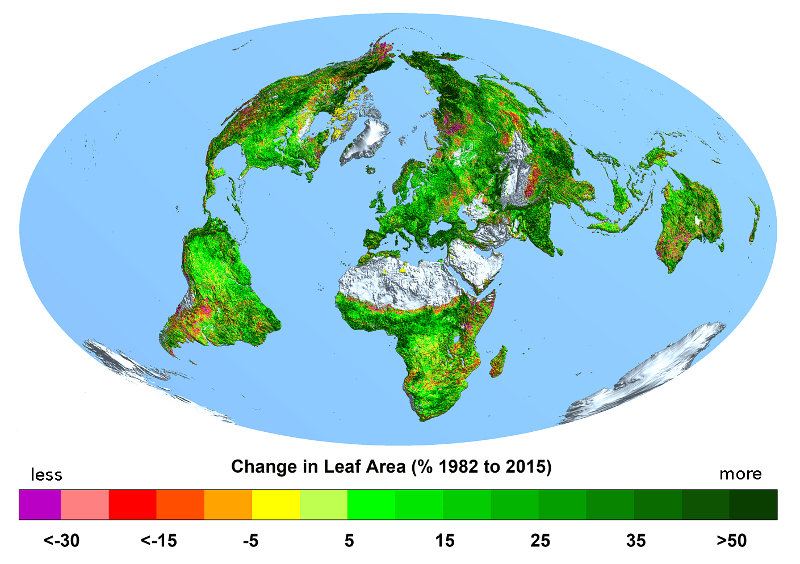
MORE GRASS GROWING MEANS LESS DUST BLOWING – Global greening as reported in the Journal Nature April 2016 – click to read more
But for the oceans as the land becomes more green, that green ground cover protects the dirt from blowing in the wind. Plant life on land, that grows in dirt and thus has access to all the minerals depend utterly on water evaporating and blowing from oceans to fall as life-sustaining rain-fall on our lands.
In the ocean plant kingdom, the phytoplankton of the ocean pastures, live in water but rely utterly on mineral rich dust-fall that blows to them from our lands to survive and thrive. As our CO2 greens and covers our land with plant life oxygen giving ocean plant life is being eradicated. A scientific paper from an ocean science group in the UK last December 2015 offered details on the very real threat to ocean oxygen from collapse of phytoplankton which when healthy produce 85% of the world’s total oxygen.
As this new NCAR report makes clear the crisis of declining oxygen production in the oceans is about to become a global disaster far sooner than the worst predictions for harm wrought by popularized global climate change effects where we live, here on land.
It is also true that the warming climate can also be expected to gradually deny the oceans of oxygen, leaving fish, crabs, squid, sea stars, and other marine life struggling to breathe. But it has been difficult to show the isolated warming effect of diminishing ocean oxygen as the ‘warming ocean oxygen’ data is a small effect compared to the ‘collapse of ocean pasture plant life.’ The authors of the report focused on whether and when this anticipated warming controlled oxygen drain will reveal a noticeable impact on ocean life. Their findings are scary to say the least.
“Loss of oxygen in the ocean is one of the serious side effects of a warming atmosphere, and a major threat to marine life,” said NCAR scientist Matthew Long, lead author of the study.
“Since oxygen concentrations in the ocean naturally vary depending on variations in winds and temperature at the surface, it’s been challenging to attribute any deoxygenation to climate (warming) change. This new study tells us when we can expect the impact from climate change to overwhelm the natural variability.”
The study is published in the journal Global Biogeochemical Cycles, a publication of the American Geophysical Union. The research was funded by the National Science Foundation, NCAR’s sponsor.
How the oceans get and share oxygen from the sunlit surface to the dark abyss
The entire ocean—from the abyssal depths to the shallows—gets its oxygen supply from the surface ocean, directly via diffusion from the atmosphere AND from phytoplankton, which release massive amounts of oxygen into the water through solar powered photosynthesis.
Warm and warming surface waters, however, absorb and lose the ability to hold onto oxygen. And in a double whammy, the oxygen that is produced and absorbed at and near the surface has a more difficult time traveling deeper into the ocean as the ocean warms. That’s because as water heats up, it expands, becoming lighter than the water below it and thus floats on colder denser deep water. Warm ocean water floats as a thick layer several hundred feet thick in oceans around the world.
A friend, Phil Nuytten, who is a pioneer in building deep submersibles once told me how much he enjoyed this temperature layering effect in the ocean. He recited that when taking one of his deep dive subs or suits down he would always have to make substantial adjustments to the bouyancy at around 500 ft down in the N. Pacific. There he said the warmer surface water was must less dense than the deep water across only a few meters at the boundary.
“It was great, when we got to the boundary of the deep cold water we’d bounce on it like bouncing of a trampoline made of jello. It was fun and we’d always pause to enjoy looking at all the exotic ocean life that like us didn’t have to expend any energy at all just sitting on that cold dense waterbed boundary of water below.”
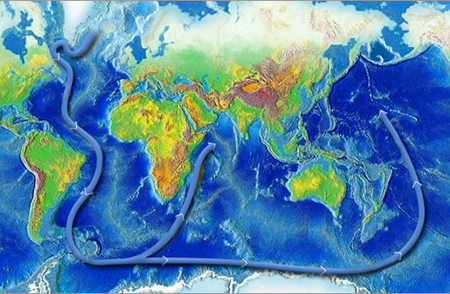
Ocean Cold Water Conveyor System moves cold water from polar seas into the deep ocean world-wide
The warm surface layers only mix with deep ocean water over time frames measured in centuries to millenia save in some few areas that harbour ocean down-welling currents where chilled polar ocean waters can sink and serve as ocean conveyor systems carrying oxygen beneath the warmer lower oxygen ocean waters in more temperate zones.
As ocean oxygen primary pasture phyto-plankton production declines everywhere due to the twin effects of our high and rising CO2 even these cold seas are losing oxygen and the sinking cold polar waters are beginning to fail to replenish oxygen into the ocean depths via the cold ocean conveyor systems.
Throughout history an exceptionally cold winter in the North Pacific or a prolific summer of plankton blooming would allow the ocean surface to soak up an extra large amount of oxygen. Thanks to the natural circulation pattern, that oxygen would then be carried deeper into the ocean interior, where it might still be detectable years later as it travels along its flow path.
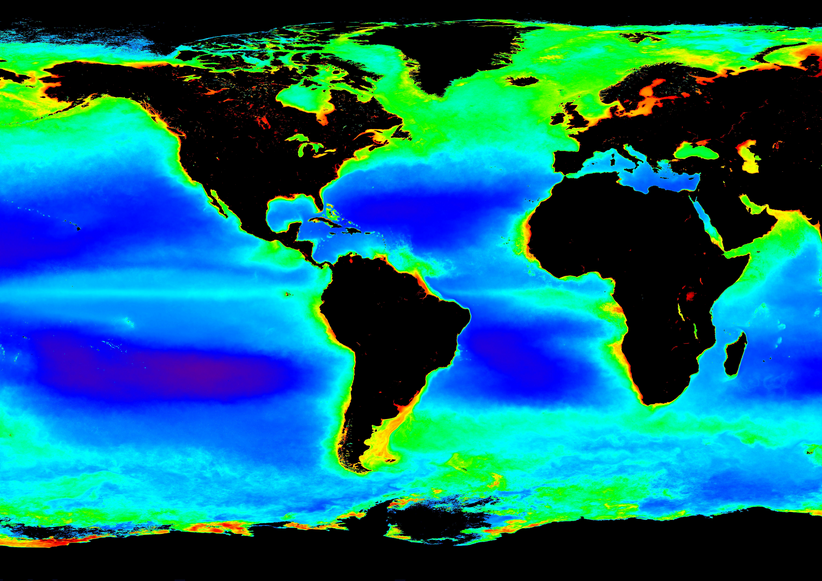
This image is linked to a story about the oceans to the west of California turning into blue deserts, unable to sustain ocean life… click to read
On the flip side, unusually hot weather aka global warming or ocean pastures turning into blue deserts due to drought of dust-fall can and does lead to natural “dead zones” in the ocean, where fish and other marine life suffocate for lack of oxygen and can neither thrive nor survive. There is very little we can do about the plight of global warming but we can immediately and sustainably restore and revive ocean plankton pastures that will keep the oceans oxygenated!
But back to the computer models
To cut through this natural variability and investigate the impact of climate change, the research team—including Curtis Deutsch of the University of Washington and Taka Ito of Georgia Tech—relied on the NCAR-based Community Earth System Model, which is funded by the National Science Foundation and the U.S. Department of Energy.
The scientists used output from a project that ran the model more than two dozen times for the years 1920 to 2100 on the Yellowstone supercomputer, which is operated by NCAR. Each individual run was started with miniscule variations in air temperature. As the model runs progressed, those tiny differences grew and expanded, producing a set of climate simulations useful for studying questions about variability and change.
Using the simulations to study dissolved oxygen gave the researchers guidance on how much concentrations may have varied naturally in the past. With this information, they could determine when ocean deoxygenation due to climate change is likely to become more severe than at any point in the modeled historic range.
The research team found that deoxygenation could already be detected in the southern Indian Ocean and parts of the eastern tropical Pacific and Atlantic basins. They also determined that more widespread deoxygenation will be certain between 2030 and 2040 if nothing is done about it.
Picking out a global pattern
The researchers created a visual way to distinguish between deoxygenation caused by natural processes and deoxygenation caused by climate change. Using the same model dataset, the scientists created maps of oxygen levels in the ocean, showing which waters were oxygen-rich at the same time that others were oxygen-poor. They found they could define a physical oceanographic method to distinguish between oxygenation patterns caused by natural weather phenomena and the pattern caused by climate change.
The pattern caused by climate change also became evident in the model runs around 2030, adding confidence to the conclusion that widespread deoxygenation due to climate change will become detectable around that time. The maps could also be useful resources for deciding where to place instruments to monitor ocean oxygen levels in the future to get the best picture of climate change impacts. Currently ocean oxygen measurements are relatively sparse.
“We need comprehensive and sustained observations of what’s going on in the ocean to compare with what we’re learning from our models and to understand the full impact of a changing climate,” Long said.
Biological Oceanography to the rescue
While the physical oceanographer authors of this paper have done a great job, they have for all intents and purposes ignored the living world of the ocean. Fortunately biological oceanographers have been studying and mapping the oceans via its living components for a many decades. The new discipline of ocean pasture management is now emerging and is offering, just as terrestrial pasture management has done on land, practical tools to restore, replenish, and safely and sustainably manage our global ocean pastures now is such a terrible state of decline.
By restoring the ocean pastures via replenishment of their missing yet vital mineral dust ocean pastures in all of the world’s seven seas can be immediately and inexpensively returned to historic productivity producing prodigious amounts of oxygen to keep the world’s lungs working and in the bargain sending billions of additional fish into our nets and onto the plates of hungry people around the world.









